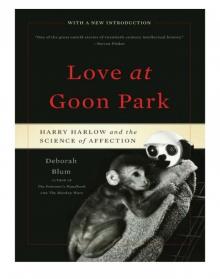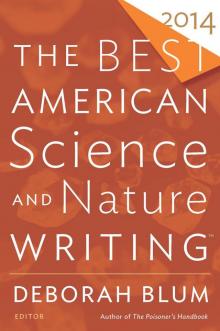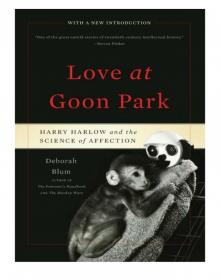- Home
- Deborah Blum
Love at Goon Park: Harry Harlow and the Science of Affection Page 21
Love at Goon Park: Harry Harlow and the Science of Affection Read online
Page 21
Skeptics couldn’t argue away the detailed, beautifully graphed primate studies from the Wisconsin lab as they had done with the more anecdotal human evidence cited by Bowlby and others before him. “With the human data you could always argue that there were unknown early experiences that had shaped them or that the populations had been preselected by the very factors which the scientists were finding. For example, if you find that kids in a hospital ward are sicker than kids at home with their families, it does not mean that being in a hospital ward produces sickness,” explains University of Georgia psychologist Irwin Bernstein, himself a long-time expert in the social behavior of monkeys. Critics couldn’t so easily dismiss the controlled, confirmed, and reconfirmed results from the surrogate mother studies. Wire mom’s inability to nurture, well, anything, just couldn’t be argued away.
“Of course, Bowlby could hardly deliberately put a human baby on a wire surrogate,” says Robert Zimmermann, one of the first collaborators in the Wisconsin cloth-mother studies. Beyond that, Zimmermann and Mason both agree that Harry’s belief that science was about life made him unusually effective in getting his points across. Harry would talk to anyone. He fiercely resisted operating on an upper-level, theoretical plane. “Bowlby was a white-collar scientist,” Zimmermann says. “Harry was a blue-collar scientist.” Mason’s analysis echoes that: “Bowlby’s style was more scholarly, more technical, more difficult to read, and more tentative than the Nature of Love, and it did not offer a simple take-home message. It was not picked up by the popular press nor as widely circulated among professionals.” Bowlby wasn’t a natural salesman. A talent for persuasiveness is not necessarily admired or cultivated by scientists. By this reckoning, Bowlby’s dry and dignified presentation helped suppress the attention given to his work. It was the showman coming up behind Bowlby in the wings—Harry Harlow with his user-friendly approach to science—who shifted the spotlight back toward the theory of attachment.
Indeed, at that moment, much of Harry’s energy was given to illuminating the message, making people listen, talking to scientists, appearing on CBS’s Conquest, telling the world that love mattered. Some of his colleagues accused him of grandstanding. Being Harry, he never allowed himself to get too carried away in his role as messenger. He was amused to find that psychology seemed to be catching up with the basic common sense of many parents. Mothers and fathers, those who had never paid attention to scientific opinions, were already aware that good mothers hug their children and that good fathers take time to play with their sons and daughters. Bob Zimmermann recalls Harlow’s return after he first took his cloth-mother research on the road. Harry was grinning, shaking his head. “Mothers know, Bob,” he said, amused that science was once again chasing basic common sense. In an interview with the St. Louis Post Dispatch, Harry joked that his lab would be designing a new, better surrogate. It would have ten arms, which would give it the minimum number of hands needed to provide adequate childcare. “It was a mother,” Harry said, “who suggested the number.”
Professor Harlow was suddenly consulted on a startling range of child-rearing techniques; not just love, but everything from naps to toilet training. Ever opinionated, he expressed his doubts over the then widely held belief that children should be toilet trained before their first birthdays. His response was classic Harry, common sense balanced with humor: “There are many techniques for early toilet training of human infants, and all have one thing in common—they do not work.” Let the child grow up and mature a little, take some time to enjoy having a baby, Harry recommended. “Masochistic mothers are, of course, welcome to enter the ordeal as early as they wish.”
He was more delighted when his work was cited in a campaign by Redbook magazine to persuade hospitals to let newborn babies and their mothers stay together. The editors named Harry’s work as proof that hospital procedures were good for neither parent nor child. Redbook was blunt: “When mother’s needs and hospital regulations collide head on, there can only be one acceptable answer—the regulations and customs must give way.” Another glossy publication, This Week (a now defunct competitor with the Sunday newspaper insert magazine, Parade) suggested that thanks to Harlow’s work, American doctors now needed education in primatology. Harry told the magazine that monkeys did indeed offer insights on child rearing. Perhaps most important, he said, is that “learning to love, like learning to walk or talk, can’t be put off too long without crippling effects.”
Stone invited Harry to Vassar in 1959. That same year, Nancy Bayley, the famed UC-Berkeley child psychologist, wrote to Harry to say that she had nominated him as a fellow in the APA’s division on developmental psychology. He wrote back to her with pleasure: “To say that I have gone developmental is almost an understatement.”
Harry was enthusiastic about The Competent Infant from the beginning. He wanted people to see that primate work could support notions of human behavior. And he wanted psychology to change. His surrogate work was a starting point, an early demonstration, as Stone put it, that the “infant does not live for bread (or milk) alone.” Elegantly cited as that was, if it didn’t signal a change in psychology, then the cloth-mother studies would be a failure. The real measure of Harry’s success would not just be in the sparkling acclaim of his time. To succeed, the field would have to go beyond momentary interest into something more substantial. There would have to be more than a flurry of stories in the popular press; scientists and public alike had to be willing to consider that relationships mattered from the first day of life. And they had to consider that babies knew this. In mother-child relationships, perhaps psychologists even needed to confront the idea that babies knew more than they did.
Stone and his co-authors did see the early glimmer of change toward the Harry Harlow view, at least when it came to the scientific perspective on how a baby connects with—sees, touches, needs—his mother. The editors of The Competent Infant thought there might even be a new consensus that “babies do not love their mothers because their mothers feed them; [that] it might be more accurate to say that infants become addicted to their mothers.” And in this, indeed, was a hint of a revolution in the making, an increasing acknowledgment of the power of a single relationship.
It’s a potent idea, that fleeting moment when we are, briefly, an addictive substance—totally loved, totally needed. We may achieve such intensity in first heat of a love affair. But it may matter more that we accomplish that be-all connection in the dawning days of life. Mothers, wrote Stone and his colleagues, are the first mesmerizing objects in a baby’s world. And even after the infant has learned to recognize and value others, a baby will still single out his mother’s face. She often remains the best-loved face for a very good reason. She’s the most there, the most responsive of any person in the baby’s world. As psychology moved away from the notion of a baby as a passive recipient—bonded blindly to the bottle or the breast—the possibility of interaction between parent and child drew sudden attention.
Harry’s cloth-mother-raised monkeys gave the idea unexpected emphasis. In the first days, the cuddly smiling cloth mother had looked as if it might be science’s answer to parenting. But consider the plight of a baby who is addicted to a statue. As scientists at Wisconsin and elsewhere watched the surrogate-mothered monkeys grow up, they became increasingly aware that the animals were in trouble. One New York reporter, visiting Madison for a follow-up story on surrogate mothers, described the one-hundred-odd monkeys with real dismay. Some clung to the bars of their cages and shrieked at passersby. Others mauled themselves, biting their arms, ripping out fur. “Many more present an unnerving picture of patient apathy,” the reporter observed. “Hour after hour, they sit in strangely contorted positions or huddle in the corners of their cages, seeming to see nothing, seeming to hear nothing.”
The worst of these—the most desperate of the rockers and biters—were those who had been raised by a wire mom. But the children of cloth moms were also unexpectedly dysfunctional animals. Cloth mom had seemed
so warm, so cozy, and so cheerfully available. At first, the researchers weren’t even sure what had gone wrong. It seems obvious in retrospect; it was less so in that uncertain time, when science was barely beginning to think about the connection between individuals and their relationships. The children of cloth mother forced Harry and his team of students to reconsider the twoway nature of a bond between two beings. Once they had, the scientists could clearly see the nature of those lost monkeys. They were babies who hugged their mothers and were never hugged back.
It doesn’t take a scientist to know that there’s no future in a relationship that is only addictive for one of the two people in it. Let’s propose that all our relationships, be they in infancy or old age or anywhere in between, work best when we actually pay attention to each other. The question that might follow is whether any theory of behavior can stretch to encompass the ever-flexible, complex, and shifting quality of a relationship? Or does it need a theory? Is it attachment behavior or is it just good healthy interaction when we watch a partner’s expressions, listen carefully, laugh once again when our children tell the same joke for the eleventh time, notice a bare flicker of sadness and move to comfort? Perhaps the two—attachment and interaction—can’t be sliced apart quite so neatly. Or at all. Bowlby always argued that part of building a secure attachment was the way the mother responded to her child—and vice versa. But there is also a distinct line of research that explores give-and-take without worrying about a full-blown theory behind it. In the first arguments of scientists over what defines a relationship, one can again see the fine breath of change just stirring the edges of psychology.
Some of the most intriguing science of, let’s say, responsiveness began with the ever useful rat. Those studies, conducted by innovative behavioral researchers such as Seymour “Gig” Levine, grew, as Harry’s mother love studies had, out of the 1950s. Levine’s work also supports the smart baby presented in The Competent Infant. Levine, who remains an advocate for the two-sided nature of all relationships, keeps the mother-child bond as a part of the story but not the whole story. “I’ve never really liked attachment theory,” admits Levine, a professor of psychiatry at the University of California-Davis. “And that’s not meant to say that the mother-infant relationship isn’t important, especially in species like our own.”
When he first started thinking about the power of relationships, Levine was a big, dark-haired New Yorker with clear hazel eyes, a rapid way of sifting through ideas, and almost no tolerance for tedium. He started tinkering with the mother-infant rat relationship after graduating with a psychology Ph.D. from New York University in 1952. Levine had begun by doing sight and hearing research, but that had bored him mindless. He’d pretty much decided to junk the whole profession of experimental psychology and become a therapist. With that thought, Levine grouchily took a research position in the psychiatry unit at Michael Reese Hospital in Chicago, where he found himself in the company of some of the best endocrinologists in the country. They were exploring the then-startling idea that experience could alter body chemistry. In particular, the Michael Reese scientists were trying to follow the bright, shifting paths of hormones in the nervous system. It was such an intriguing idea that “the whole world opened up for me,” Levine says. The senior scientists at Michael Reese were interested in the body’s stress response. People knew, of course, that unhappiness and stress impaired disease-fighting abilities; hadn’t they seen that very thing in the hospitalized children? But they had no clear idea how that happened and why.
Levine decided to tackle stress in an animal model, beginning with the rat. He was curious about whether events during infancy led to the development of psychological disorders. He came up with a very simple experiment—it would compare three groups of infant rats. The first—and theoretically the luckiest—would simply stay cuddled into their cage with mother. The second would be taken out once and exposed for three minutes to a mild electric shock, “as a model of early trauma.” The third group would also be removed for three minutes, but only to another location. For comparison purposes, they would also be “handled” but not shocked. Levine wasn’t thinking about relationships particularly; he was just looking for a good stress response. He applied for a federal grant to support his experiment. The scientist who came to review his proposal was a slight, sardonic Wisconsin psychologist, Harry Harlow, none other, who thought the work sounded pretty damn interesting and successfully recommended $8,000 in funding. “He was very supportive,” Levine says. “This was about the same time he was doing the monkey work, so he got the experiment immediately.”
Levine had a straightforward idea. He would create a model of a sheltered infancy compared to a stressed-out one. Then he would observe both sets of animals as adults. Would the traumatized infants grow into neurotics? Would the cozy homebound rats mature into extra confident rodents? As the rats aged, he ran all three groups through a simple stress test, an electric shock that could be ended by simply skittering away from the charged floor grid. The results contradicted every expectation. The non-handled rats looked almost the opposite of confidant. They were the slowest learners. They were the most insecure. The tingle of the electric shock agitated them; they could barely bumble their way to safe ground. By contrast, the handled and even the shocked rats grew into pretty cool customers. They were quick to respond, sure-footed in their move to escape the shock, and they displayed far less angst. It wasn’t only the reversed effect in behavior that startled the scientists. “We all looked at each other and said, ‘How the hell could three minutes have such a profound effect?’” Levine recalls.
The potency of a 180-second time-out served as a reminder that a living creature must be exquisitely tuned to its environment. Apparently, the body generates a reaction even to the slightest change in circumstance. The scientists began to suspect that the early handling of the rats, the early exposure to stress, altered the neural circuitry of the brain. The experience itself might be brief, but the effect—generated by some unknown tweaking of brain chemistry—was surprisingly long lasting.
What was going on? Levine wasn’t sure. He decided to explore further, this time with another version of the strange-situation test. For the rats in his research project, this meant being sent into an open-field test. To a rodent, a wide-open area can be perilous terrain, offering no possibility of shelter to a small animal always poised against the possibility of predators. Levine’s tests alternated that dangerously empty space with an open field spiked with new objects and toys, much like the open field used in Harry’s lab. Levine had a growing list of questions. Would the rats panic at being so vulnerable, perhaps freeze in place? If he placed some interesting toys in the room, would they be curious enough to explore?
Again it was the mom-sheltered rats that fumbled the challenges. They froze. They peed uncontrollably. They trembled at the sight of a new object. Later experiments showed that even when scientists put a treat in the open field, such as sugar water, the sheltered rodents were afraid to check it out. It was the handled rats who sucked up the treat. The non-handled rats never seemed quite sure that they could trust their senses. It appeared they were overwhelmed by their agitation when anything new or different happened, so much so that they could hardly make a reasonable choice. They seemed perpetually tuned to the anxiety channel in their brains. The earlystressed rats, by contrast, seemed to be listening in on the easy rock station. They looked unfazed by new situations—and they looked smarter. This made absolutely no sense, at least not until the scientists had rethought some of their ideas about what goes into a healthy childhood.
Levine and his colleagues came to appreciate that babies—even baby rats—need interest and interaction in their lives. Even a stressful interaction can be better than no interaction at all. Stress, in this case, does not mean an extreme situation, such as an abusive parent. It refers to everyday tensions. The truth is that even the most loving parents succeed in stressing their babies. Infants are picked up when they are sl
eepy and passed about so that strangers can admire them. They are fed strained spinach when they really want apricots. They are plunged into baths when they were happy being dirty, thank you. Interesting objects are taken out of their mouths. Baby life is, when you think about it, a daily barrage of frustrations. And maybe, too, if you think about it, all these little hassles prepare you for the big hassles, toughen you up gradually, are comparable to putting your stress system through a few healthy push-ups and bench presses.
When the infant rats were moved around, their stress hormones went up. The brain was forced to respond to that, to regulate the response, to fine tune the stress level itself. The workout seemed to make the brain more flexible, so that the baby rats who were handled were better able to adjust to later demands. The more sheltered rats seemed to come up with an all-or-nothing stress response. They were almost equally upset by the maze and the electric sizzle, which turns out to be not a particularly helpful way of reacting. And to Levine, this strongly suggests that some challenging experience—as long as it’s not an overwhelming traumatic experience—may be helpful, even necessary, in building the kind of body response system that will serve us best.
Does this mean that being mothered is bad for you? Does it call up that old stereotype of the overprotective mother? Not at all. If you compare the two groups of rats carefully, you realize that the stay-at-homers weren’t living in some well-mothered paradise. They were spending their infancy locked in a box with a bored and often apathetic adult female. There’s nothing normal about that. In nature, the mother moves around, leaves to hunt for food. Other rats come and go, and the odd predator makes a terrifying appearance. In a small cage, food and water placed right there, the world becomes pretty small and dull. The mother can become lethargic. Remember that the handled rats weren’t undergoing lengthy separations from their mothers, either; they were spending three minutes out of every twenty-four hours away from home.

 Love at Goon Park: Harry Harlow and the Science of Affection
Love at Goon Park: Harry Harlow and the Science of Affection The Poison Squad
The Poison Squad Ghost Hunters: The Victorians and the Hunt for Proof of Life After Death
Ghost Hunters: The Victorians and the Hunt for Proof of Life After Death The Poisoner's Handbook
The Poisoner's Handbook Angel Killer
Angel Killer The Best American Science and Nature Writing 2014
The Best American Science and Nature Writing 2014 The Ghost Hunters
The Ghost Hunters Love at Goon Park
Love at Goon Park